16.07 to 18.07.09, 2 days, currency rate 1 € = 1.12 M (New Manat)
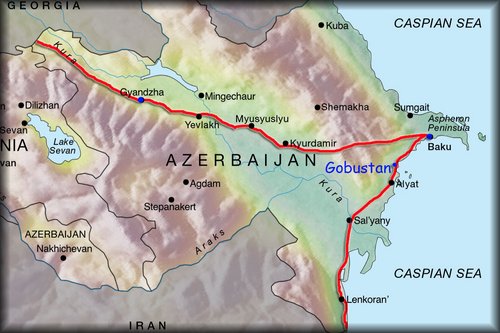
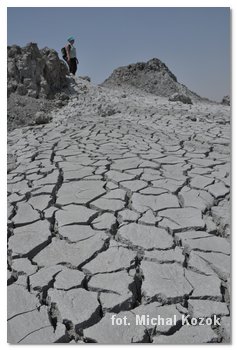 highlights – Azerbaijan wasn't so hospitable like Georgia and Armenia. The first shock for us was refusing to store our luggage for few hours in the small bus terminal's cafes or restaurants - even when we promised to eat there after our return. As well we had to bargain to get a fair price for a ride. Of course the country had some nice accents, sometimes people have helped us. In Azerbaijan I felt “I had one foot in Asia” (which I didn't feel in the two previous countries). It is one of the most open and tolerant Muslim countries. Here you can see the alcohol consumption in public places, you can order pork in restaurants, you can also find the women in tank tops and short skirts.
highlights – Azerbaijan wasn't so hospitable like Georgia and Armenia. The first shock for us was refusing to store our luggage for few hours in the small bus terminal's cafes or restaurants - even when we promised to eat there after our return. As well we had to bargain to get a fair price for a ride. Of course the country had some nice accents, sometimes people have helped us. In Azerbaijan I felt “I had one foot in Asia” (which I didn't feel in the two previous countries). It is one of the most open and tolerant Muslim countries. Here you can see the alcohol consumption in public places, you can order pork in restaurants, you can also find the women in tank tops and short skirts.
Currently there are two currencies at time - the old and new manat. It shouldn't be nothing special, but the conversion ratio is 1:5000. This is probably in order to develop the mathematical skills of the country inhabitants – try to imagine the old grandpa who buys a newspaper every day for 2000 old manats. This time he pays with 10 new manat note and receives the change: 5 new manat and 23.000 old manats. Grandpa takes money and has no idea whether the change is correct.
Our first stopover we made in Ganja. We went to see Imanzada – the brick mausoleum with a blue dome surrounded by a cemetery (watch out for snakes). Mausoleum is not special but it was nice to go somewhere around the town to feel the atmosphere of a new country. And it was warmer, different food taste, some nice people inviting for eating and drinking together (as in the previous countries that was hosts honour to pay).
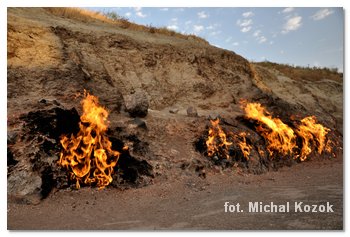 After visiting Ganja we went to the capital by night bus. Baku is situated next to the largest lake in the world, the Caspian Sea (depression more than 20 meters below sea level). On the lake side there is lively bright promenade, where people are walking, eating, listening to music. We did a walking tour of old town - beautiful European architecture with the Muslim influence. Inside the old city walls is the prettiest part of the old town. The capital has a great nightlife with many pubs and clubs open till morning, it doesn't seems to be an Islamic city. One time Baku was one of the richest city in the world – it is built on oil. Its glory days have passed, but it still looks clean, rich and civilized - recently even applied to be the Summer Olympic host. Nobel brothers made their fortune here (one of them, Alfred, invented dynamite and later became well-known founder of the Nobel Prize).
After visiting Ganja we went to the capital by night bus. Baku is situated next to the largest lake in the world, the Caspian Sea (depression more than 20 meters below sea level). On the lake side there is lively bright promenade, where people are walking, eating, listening to music. We did a walking tour of old town - beautiful European architecture with the Muslim influence. Inside the old city walls is the prettiest part of the old town. The capital has a great nightlife with many pubs and clubs open till morning, it doesn't seems to be an Islamic city. One time Baku was one of the richest city in the world – it is built on oil. Its glory days have passed, but it still looks clean, rich and civilized - recently even applied to be the Summer Olympic host. Nobel brothers made their fortune here (one of them, Alfred, invented dynamite and later became well-known founder of the Nobel Prize).
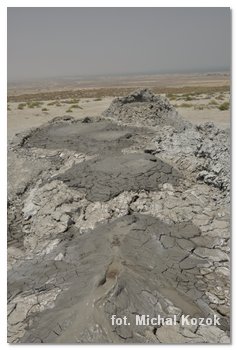 We went to see "the flaming rocks" and on the way we passed the oil fields with non-stop working drilling machines - wherever you look, you will see pumps, between the houses, near the playground etc. Although I had imagined "burning rocks" quite differently (in the open field, not in niche behind the building) I was impressed anyway, because I like "strange freaks of nature." It is a place where for hundred of years the gas escaping from the deep earth continuously burns. Interesting phenomenon and in addition to it, the fire is without a smoke, because it burns 100% clean natural gas. Although the next time I would go there at night, the effect would be probably even better.
We went to see "the flaming rocks" and on the way we passed the oil fields with non-stop working drilling machines - wherever you look, you will see pumps, between the houses, near the playground etc. Although I had imagined "burning rocks" quite differently (in the open field, not in niche behind the building) I was impressed anyway, because I like "strange freaks of nature." It is a place where for hundred of years the gas escaping from the deep earth continuously burns. Interesting phenomenon and in addition to it, the fire is without a smoke, because it burns 100% clean natural gas. Although the next time I would go there at night, the effect would be probably even better.
Later we went to Gobustan, famous for its petroglyphs and different finds of daily use from our early civilization, even like 34-36 thousands years ago! Rock rites are on UNESCO list, but we did not have the impression (but I'm not an expert). The surrounding area doesn't belong to the prettiest one as well. We didn't get the student discount – entry fee 3 M (2.7 €). Due to problems with transport we didn't go to the inscription left by Alexander the Great. Coming back we caught the police car which quickly became our "taxi" and took us to the mud volcanoes. It is a hill with some cones in size from a few centimeters to several meters, this small volcanoes are throwing out the mud. We put our hands into it – the mud was cold. Mud volcanoes occur only in a few places in the world. From a distance we could see the blue color of Caspian Sea, but the area around was a mix of loose soil and gravel, so in hot windy day all was dusty.
| town | site | price in M | €/ per | duration | note | comments |
| Ganja | Imanzada Mausoleum | - | - | 30' | no good | |
| Baku | flaming rocks | - | - | 15' | ok | |
| Gobustan | petroglyphs | 3 M | 2.7 € | 1 h | no good | outdoor rites and indoor museum |
| mud volcanoes | - | - | 30' | ok | ||
| €3 |
![]()
accommodation – we spent two nights in the buses.
![]()
transport – we wanted get to the Iranian border by a cheap train - but there were no tickets available. It has known that in the post Soviet system "no" might mean many things. We had no time to try get lucky so we went to the bus station. Unfortunately the last bus to Astara leaves at 4pm. In this case we were looking for Iranian Bus Station – close to the train station in street called May 28 take a bus number 30 or 332 and get off near the Araz hotel. Ask people for "Iran garage”. Bus to Tehran departs at 10 pm. We reached the border in the middle of the night and waited until 9 am to open it.
We were looking for public transport to the "flaming rocks" for a long time. Finally we gave up and decided to get to the Gandzlik subway station, from where it's much closer to the destination. We took a cab and asked the driver to wait for us for 20 minutes at the site.
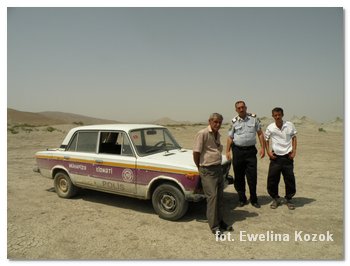 We got to Gobustan by bus no 105. Passengers will tell you where to get off. There taxi drivers will attack you. The petroglyph site is about 5 kilometers to the northeast from the intersection where you have got off. You can see the park administration building on the cliff and the street with lamps along the driveway to the entrance gate. We took a one way taxi and on the way back we caught police “Lada”. Driver agreed to give us a lift to the town, but along the way we got agreement for a mud volcanoes trip. There is just 9 km but it is very difficult to find it (95m, N 40°02.623 'E 49°26.406').
We got to Gobustan by bus no 105. Passengers will tell you where to get off. There taxi drivers will attack you. The petroglyph site is about 5 kilometers to the northeast from the intersection where you have got off. You can see the park administration building on the cliff and the street with lamps along the driveway to the entrance gate. We took a one way taxi and on the way back we caught police “Lada”. Driver agreed to give us a lift to the town, but along the way we got agreement for a mud volcanoes trip. There is just 9 km but it is very difficult to find it (95m, N 40°02.623 'E 49°26.406').
City transport in Baku - bus 0.2 M (0.2 €) and just 0.05 M for a metro.
| day | destination | transport | price in M | €/ per | duration | km |
| 9 | border - Ganja | minibus | 5 M | €4.5 | 2.5 h | 152 |
| 9 | Ganja - Imanzada + return | taxi | 3 M/ 2 per | €1.3 | 2x 10' | 2x 5 |
| 9-10 | Ganja - Baku | night bus | 6 M | €5.4 | 7 h | 370 |
| 10 | Baku - Gobustan | bus no 105 | 0.8 M | €0.7 | 1.5 h | 60 |
| 10 | Gobustan - petroglyphs + return | taxi + hitchhiking | 3 M/ 2 per + 0 | €1.3 | 2x 10' | 2x 5 |
| 10 | Gobustan - volcanoes + return | taxi (hitchhiking) | 10 M/ 2 per | €4.5 | 2x 20' | 2x 12 |
| 10 | Gobustan - Baku | 2x minibus | 1 M | €0.9 | 1 h | 60 |
| 10 | Baku - flaming rocks + return | taxi | 12 M/ 2 per | €5.4 | 1 h | 2x 15 |
| 10-11 | Baku - Teheran (Iran) | night bus | 22 M | €19.6 | 22 h | Azerb. 323 Iran 500 |
| city transport | taxi, metro, buses | 4.6 M/ per | €4.1 | - | - | |
| €48 | 1039 |
![]()
visa – we arranged our visa in Tbilisi, Georgia. Azerbaijan Embassy is located on No 1 Kipshidze St, open Mon, Wed and Fri between 10:30 and 12 pm. For a transit visa there is no problem - we had to have already a visa to the next country (in our case Iran), and after completing an application we paid $ 20 and 5 Georgian lari “commission” (with no receipt). Normally payment should be made in the Azeri Bank, No 4 Marcahi Svili Kucesi St. but that could be a problem to back to embassy on time. We received 5-day transit visa on the same day (between 4 and 5 pm).
Unfortunately, when it comes to a tourist visa, it's not so easy. We have heard about denied applications, necessary reservations, letters of invitations etc. Cost in Tbilisi was $ 60 (US, British and Israelis $ 100). However, as I've read on the embassy website, you can obtain a visa at the airport in Baku.
Due to the very tense relations with Armenia, it is recommended not to travel with Nagorno-Karabakh visa in the passport – the entry to Azerbaijan will be refused. Problems may even occurs when custom officers will find on you some Armenian souvenirs or a map with designated area of Nagorno-Karabakh as part of Armenia.